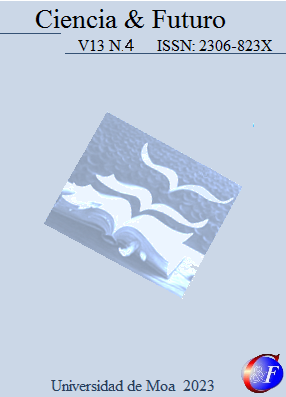Caracterización físico-metalúrgica de una unión disímil soldada por fricción
Palabras clave:
acero inoxidable, aleaciones, junta de soldadura, parámetros de soldaduraResumen
Se estableció el comportamiento microestructural y la dureza, en una unión disímil entre la aleación de cobre Cu-DHP y el acero AISI 316L mediante soldadura por fricción rotativa. La junta se realizó con número de revoluciones de 1 200 r/min en barras de 12 mm de diámetro y 100 mm de longitud, se aplicó presión de soldadura de 30 MPa. Las variables del proceso fueron el tiempo de soldadura, la presión y el tiempo de forja. En la zona termomecánicamente afectada y la térmica afectada, se pudo determinar que, existe la presencia de fase α y β y óxido cuproso (Cu2O) en el lado del Cu-DHP y en el acero AISI 316L, la presencia de la fase austenítica equiaxial, con ferrita en la matriz. La dureza se incrementó desde 89,7 HV en el cobre y 217 HV en el AISI 316L hasta 250 HV en la ZTMA.Descargas
Citas
Buffa, G., Fratini, L., Pasta, S. y Shivpuri, R. (2008). On the thermo-mechanical loads and the resultant residual stresses in friction stir processing operations. CIRP Annals-Manufacturing Technology, 57(1), 287-290. https://www.sciencedirect.com /science/article/abs/pii/S0007850608000346.
Guzmán-Romero, E., Fernández-Columbié, T., Alcántara-Borges, D. y Rodríguez-González, I. (2017). Efecto de la velocidad angular y la presión en el proceso de soldadura por fricción radial en una aleación de aluminio AA 5754. Minería y Geología, 33(3), 312-325. https://revista.ismm.edu.cu/index.phprevistamg/view/art5_No3_2017.
Kimura, M., Fuji, A. y Shibata, S. (2015). Joint properties of friction welded joint between pure magnesium and pure aluminium with post-weld heat treatment. Materials and Design, 85(10), 169-179. https://www.sciencedirect.com /science/article/abs/pii/S026412751530068.
Koteswara, P., Mohan, V., Surya, N. y Krishna, G. (2017). Effect of speed on hardness in rotary friction welding process. International Journal of Materials Science, 12(4), 635-641.
Mercan, S., Aydin, S. y Ozdemir, N. (2015). Effect of welding parameters on the fatigue properties of dissimilar AISI 2205–AISI 1020 joined by friction welding. International Journal of Fatigue, 81(12), 78-90. https://www.sciencedirect.com /science/article/abs/pii/S0142112315002327.
Mumin, S. (2009). Joining of stainless steel and copper materials with friction welding. Industrial Lubrication and Tribology, 61(6), 319-324.
Mumin, S. (2016). Optimizing the parameters for friction welding stainless steel to copper Parts. Materials and technology, 50(1), 109-115.
Shanjeevi, C., Jeswin. J., Arputhabalan, R., Dutta, D. y Pradeep, S. (2017). Investigation on the effect of friction welding parameters on impact strength in dissimilar joints. Materials Science and Engineering, 197(100), 3-7. https://iopscience.iop.org/ /article/10.1088/1757-899X/197/1/012069/meta.
Seshagirirao, B., Sivaramakrishna, V. y Saikrishnaprasad, G. (2015). Experimental investigation of rotary friction welding parameters of aluminum (H-30) and mild steel (AISI-1040). International Journal of Innovative Research in Science, Engineering and Technology, 4(5), 2920-2925.
Sriram, R. y Ramadoss. R. (2015). A study on mechanical and metallurgical properties of friction welded dissimilar materials. International Journal for Research in Applied Science & Engineering Technology (IJRASET), 3(1), 32-38.
Suppachai, C., Chaiyoot, M. y Muhamad, T. (2017). Rotary friction welding of dissimilar joints between SSM 356 and SSM 6061 aluminum alloys produced by GISS. Engineering Journal, 21(1), 181-191. https://doi.org/10.4186/ej.2017.21.1.181.
Weglowski, A. & Pietras, A. (2011). Friction stir processing-analysis of the process. Archives of metallurgy and materials, 56(3), 779-788. https://journals.pab.pl/dlibra /show.conent?id=85843.
Publicado
Cómo citar
Número
Sección

Esta obra está bajo una licencia internacional Creative Commons Atribución-NoComercial 4.0.
Esta obra está bajo una Licencia Creative Commons Reconocimiento-NoComercial 4.0 Internacional
La Revista Ciencia & Futuro es una revista de acceso abierto, todo el contenido está disponible gratuitamente sin cargo para el usuario o su institución. Los usuarios pueden leer, descargar, copiar, distribuir, imprimir, buscar o vincular los textos completos de los artículos, o utilizarlos para cualquier otro fin lícito, sin pedir permiso previo al editor o al autor. Todo lo anterior, de acuerdo con la definición de BOAI de acceso abierto.
Los autores que publican en esta revista están de acuerdo con los siguientes términos: Licencia Creative Commons Atribución-NoComercial permite que el beneficiario de la licencia tenga el derecho de copiar, distribuir, exhibir y representar la obra y hacer obras derivadas para fines no comerciales siempre y cuando reconozca y cite la obra de la forma especificada por el autor o el licenciante. Los autores pueden establecer por separado acuerdos adicionales para la distribución no exclusiva de la versión de la obra publicada en la revista (por ejemplo, situarlo en un repositorio institucional o publicarlo en un libro), con un reconocimiento de su publicación inicial en esta revista. Se permite y se anima a los autores a difundir sus trabajos electrónicamente (por ejemplo, en repositorios institucionales o en su propio sitio web) antes y durante el proceso de envío, ya que puede dar lugar a intercambios productivos, así como a una citación más temprana y mayor de los trabajos publicados (Véase The Effect of Open Access) (en inglés). Lo anterior debe realizarse siempre sobre el artículo ya publicado por Ciencia & Futuro.
Los autores mantienen el control sobre la integridad de sus trabajos y el derecho a ser adecuadamente reconocidos y citados.
A los editores se les otorgan derechos no exclusivos para publicar y distribuir.







